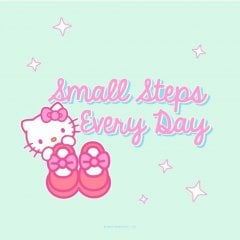Search the Community
Showing results for 'vegetarian'.
Found 4,910 results
-


Frustrated and depressed
BLERDgirl replied to dem16's topic in POST-Operation Weight Loss Surgery Q&A
I didn't have a pre-op diet and I didn't do only liquids until the day before which was required by surgery. I also did not have a post-op clear liquid phase. I went straight to full liquids. What I did do was work my butt off. I log my food, drink my Water, keep my Protein up and work out. I had a large weight loss the first 2 weeks (26lbs), but that was to be expected because I started at such a high BMI. At my 6 week f/u I loss another 6lbs. That when I knew I needed to knuckle down and work. Since then I've averaged 8 -10 lbs monthly and I'm absolutely fine with that. A year out and I have lost a little over 100lbs since day of surgery. It's not coming off lightening fast, but I have nearly no sagging skin and feel great. I a also vegetarian and therefore my carbs run higher than most. I make sure they are complex carbs and not from things like breads and highly processed food. I also stay active enough to burn those carbs off. I am also post menopausal and take medication that slows my metabolism. I am living proof this tool works if you work it. To the OP, I repeat, step away from the scale. Focus on good eating, getting in your fluids and moving. -
Okay Julie, you're not totally without a fix. A hotel I stayed at in Houston actually had bathroom scales available via the concierge desk. It never hurts to ask. If necessary, scoot out to the local store and buy a cheap one to keep in the hotel. You can leave it with the concierge for the next scale whore who needs one. (grin) The next part depends on location and type of hotel. Most hotel restaurants are used to a few "bizaare" requests, like bringing a child's menu for an adult, or letting said adult order from just the appetizer menu. You won't be the first bandster to travel there, unless you're going to Outer Mongolia. The hotel I'm going to in Orlando in April has already reassured me they'll have a mini-refrigerator waiting in my room for my shakes and special foods. (Call ahead and reserve one, especially if you're going to a convention.) I have a roomie on insulin for the Romantic Times Convention, so the fridge is doubly necessary. Also, I've already bought and packed a couple boxes of Crystal Light On the Go. I'm driving down, so I'm taking a case or two of my own water rather than pay for the high-priced bottled water available in the hotel shop. However, when in Houston I bought the darn water at the same price I would have paid for my usual double-chocolate latte. I ground my teeth to keep from ordering the coffee, and whimpered all the way out the door. The probably thought I was insane, but I made it out alive! LOL! My biggest problem at conventions are the "special parties" thrown for convention-goers. Chocolate and pastries are prevalent, but I managed to put a bug in a few ears well in advance that "healthier choices" like crudites for the vegetarians and low-carb items might be wise. I joined up with the diabetics and vegetarians I knew to come up with alternate ideas to give to the grateful party planners. Hopefully, there will be something better. Speaking of my vegan and diabetic friends, I deliberately sought out those folks like myself with special dietary needs. There will be a large table of us at the convention, sharing out the food. The one vegan was pitifully grateful to find out she doesn't have to starve by herself. The three bandsters and two diabetics I found (and I) have all promised to give her our vegetable side dishes from our restaurant meals if she polices us away from the carbs. "Fair dinkum!" as the Australian diabetic emailed me. LOL! A little bit of advance planning helps a great deal! Good luck!
-


How Much Do/Did You Know About Nutrition?
BLERDgirl replied to Alex Brecher's topic in Food and Nutrition
I knew quite a lot. I've been vegetarian for nearly 20 years. Serious about it for the past 7 (as in not just eating a bunch of pasta and veg.) I had changed my eating about 3 years prior to considering WLS. My allergies had gotten to the point where I was always sick and I tend to be the small percentage that reacts negatively to too many meds. I was practicing clean eating, had stopped drinking soda and was food logging before I thought about surgery. In fact it was one of the things that helped me decide. I felt that if I was eating properly and exercising, the extra help from surgery might make my weight loss successful. -


Has anyone gone VEGAN while banded? And were you successful?
B-52 replied to Beachy_Babs's topic in LAP-BAND Surgery Forums
A few months after being banded, and after my 2nd fill, it became difficult to eat Red meat of any kind...since my Dr.'s have always been after me to cut back on Red Meat for health reasons, I decided to stop altogether....no red meat for over 2 years now.... I had already stopped dairy products, again because of health reasons, long before being banded....a little cheese here and there but that's it. I do eat chicken and fish, but I am cutting back on chicken more and more....eventually I may go all vegetarian.... I can definitely tell the difference physically....and I am sure it had a lot to do with my now "Normal" lab tests (blood work) along with loosing all my excess weight from the band. I do it for health reasons....not for moral issues....I still wear leather shoes, etc... -
Would you all be interested in a forum where you could discuss vegetarian and vegan options without any pressure? We'd of course have an emphasis on getting in as much B12, Protein, etc. as possible but without the pressure thrown at us to have meat. I know I felt uncomfortable with my surgeon who always pushed those things or just Beans at me when I couldn't do them.
-
Sometimes I get Mexican restaurant carry out, which is just as fast as a drive-through if you call ahead. Personally I am a vegetarian and just get an order of refried beans and some fresh salsa to put over them, but my husband likes steak or chicken fajitas, which would be a good VSG-friendly food with no tortillas. Would probably last a few meals, too.
-
Hey, hey, hey...I didn't get to the top of the food chain to eat plants. Aww, that's not true. I'm a vegetarian. Not because I love animals...it's because I HATE plants.
-
I noticed the vegetarian one was missing, too, but I thought maybe I just couldn't find it again. I was really enjoying that, too. I did post the seitan recipe someone asked about, so maybe that will get it going again... Emily
-


How many carbs is to many carbs a day?
riley4183 replied to thinneranniesoon's topic in POST-Operation Weight Loss Surgery Q&A
~sigh, I know I should not worry about this question either, but I do!! Too many years of following south beach, plus my support groups are all about the low-carb thing - but they are mostly RNY also, maybe that makes a difference. I do log everything in caloriecount.about.com and it works for me. I get 70 to 80 grams of carbs a day, but I also aim for at least 30 grams of Fiber so make that 40 to 50 net grams of carbs. That's low enough for me to lose at a good healthy pace but still feed my essential body functions, which you must have carbs for your body to use or it will use lean muscle and we don't want that! I can't do gluten so bread products are out for me, and rice is out per my lap-band program, and milk is out due to lactose & whey intolerence SO I get all of my carbs from fresh fruit (I mostly eat berries for the high fiber) in the a.m., vegies, unsweetened soy milk and an occasional few bites of potato or sweet potato (potatoes are a trigger food for me so I avoid them most of the time). Sometimes quinoa, maybe once a week or so. I very rarely eat processed foods and feel lousy when I do (listen to Jachut!) I am also vegetarian so I get a few carbs from the soy meat analogs and tofu products that I consume every day (I usually get 80 grams or more of Protein, don't need meat to do that!). My nutritionist always says protein first, followed by fruit or veggie, starches last and if you never do get to the starches that's just fine with her! I follow her advice and it works for me :cool: -


What I think of Oprah's show today!
laurenica23 replied to Apples2's topic in LAP-BAND Surgery Forums
I'm not a big fan of Oprah, either. However, I do think Dr. Oz has some good things to say. He's a very intelligent doctor who makes well informed decisions. His wife is a vegetarian and I think he's more of a "in moderation" guy than a specific diet guy. He enjoys eating meat, but at home, eats what his wife cooks and finds her vegetarian dishes delicious and healthy. To me, it seems that lately Oprah is putting a lot of blame on her thyroid problems. I don't watch her show that much, but from what I've seen this is the impression I get. I have hypothyroidism as well. I was talking to my mom about it the other day (she's a nurse practitioner) and asked her since my thyroid imbalance is controlled with medicine, if it would be difficult for me to lose weight. Some of it may be that I have age on my side, but she told me since it's well controlled, it shouldn't be too difficult to lose weight. The fact is, I can't blame my weight on my thyroid problems anymore. I respect her decision to NOT have weight loss surgery. At the same time, I think she should respect the decisions of others who have had weight loss surgery. The statistics are there -- a lot of people who have a lot of weight to lose tend to gain it back after a while. For me, the lap-band is a tool for me to keep my appetite in check as I lose weight and when I get to the point of maintenance. Obesity is a serious health issue and surgery is one way to treat that issue. -


A Thorough Pre And Post Op Sleeve Diet And Tips(Long)
peacequeen posted a topic in PRE-Operation Weight Loss Surgery Q&A
LAPAROSCOPIC GASTRIC SLEEVE DIET Introduction The following information provides guidelines for you to follow before and after Gastric Sleeve Surgery and for the rest of your life. Gastric Sleeve Surgery is a weight loss tool. After surgery, you will be required to make lifelong changes in your eating habits and to exercise on a regular basis in order to achieve and maintain your weight loss goals. Gastric Sleeve Surgery reduces the size of the stomach which restricts the volume of food that you can consume at one time. This means that you will feel full after eating a small amount. The surgery also induces hormonal changes which help prevent you from feeling excessively hungry. You should avoid drinking liquids with meals. This is to prevent overfilling of the stomach. Frequent snacking or grazing must also be avoided as this contributes to excess calorie intake and can slow weight loss or cause you to gain weight. Exercise is an important component of weight loss success. Exercise is recommended before and after surgery in order to maximize the amount of weight that you lose and keep off. If you have not been an active exerciser, always consult with your physician for clearance and recommendations before beginning any exercise program. It is important to follow the lifetime Gastric Sleeve diet rules, supplement guidelines, and exercise recommendations in order to achieve and maintain optimum weight loss success. In order to begin preparing for surgery, start implementing the pre-surgery diet goals listed on the next page. 4 Pre-Surgery Diet Practice Tips 1. Choose low-fat foods, and avoid fried foods. 2. Stop using sugar. Use sugar substitutes such as Sweet & low, Equal, or Splenda. 3. Decrease intake of Desserts and candy. 4. Stop drinking sugar-sweetened beverages such as regular soda and sweetened Kool-Aid. 5. Start weaning off of caffeine and carbonated beverages. 6. Start cutting back on fast food and eating out. Begin making healthy meal choices when eating out and at home. 7. Eat 3 meals a day. Do not skip Breakfast. 8. Start decreasing portion sizes. 9. Eat more fruits and vegetables. 10. Practice drinking water and other fluids between meals, not with meals. 11. Drink 64 ounces Water a day. 12. Practice sipping liquids. 13. Avoid alcohol. 14. Begin some form of exercise. 15. Review the following information on the gastric sleeve diet. 16. Practice chewing foods thoroughly, 20 - 40 times or to paste consistency. 17. Purchase your protein drinks or supplements. 18. Purchase your vitamin and mineral supplements. 19. Begin planning a schedule for mealtime, fluids and Vitamin and mineral supplements. 5 Post Gastric Sleeve Surgery Diet Important Diet Guidelines: 1. Eat 3 meals per day. Avoid snacking and grazing. 2. Eat small amounts. Initial portion size should be no more than 1 - 2 ounces - approximately 2 - 4 Tablespoons - of food per meal for the first month. At first you may not be able to tolerate this amount. Over time, you will slowly tolerate more volume at each meal. Long term, the stomach will eventually hold about 4 - 8 ounces (1/2 - 1 cup) of food per meal. 3. Eat Protein foods first. 4. Do not try to eat food and drink liquid together. • Consume liquid 30 to 60 minutes before and/or 30 to 60 minutes after eating meals but not during meals. 5. You are required to take a multi-vitamin with minerals for the rest of your life. 6. Eat slowly! • Each meal should last 30minutes or longer. • Avoid gulping foods and drinks. • All foods must be well-chewed to a paste consistency. • Using a small fork or spoon (i.e. baby utensils) can help control portion sizes. • Have one place to eat (such as at the table) and avoid reading or watching TV while you eat. This helps you to enjoy your food, concentrate on eating slower and to realize when your stomach is full. 7. Drink plenty of calorie-free, non-carbonated, caffeine- free fluids between meals . • Drink slowly-sip fluids, never gulp. • Calorie-containing beverages should be limited to skim milk and Protein Drinks. • Limit juice to no more than 4oz. per day. • Consume zero-calorie beverages throughout the day. 6 Diet Progression After Surgery The diet after gastric sleeve surgery progresses through several stages. Your surgeon will let you know when it is okay to progress to the next stage. Day 1 - 2 after surgery: Clear Liquid Diet The clear liquid diet means fluids or foods that are liquid at body temperature and can almost be seen through. You will be on a clear liquid diet while you’re in the hospital. Examples of Clear Liquid Diet (No Added Sugar/ Sugar Free): • Clear (diluted) fruit juices without added sugar: apple, grape or white grape or diet cranberry • Sugar-free Crystal Light drink mix or popsicles, sugar-free Kool-Aid • Herbal tea, caffeine-free tea • flat soda • Sugar-free Popsicles • Sugar-free gelatin • Clear broth • Water ???? It is best to dilute juices by 50% with water. ???? Avoid citrus juices (orange/grapefruit) and tomato juice for the first three weeks. ???? Coffee and de-caffeinated coffee contain acids which are irritating to the stomach lining and should be avoided for the first few weeks for healing. Day 3 through Week 2: Full Liquid Diet The next stage is the full liquid diet which consists of sugar-free, low-fat milk products and the Clear Liquids listed above. You will need to supplement with protein (drinks or powder) after surgery. Remember to sip liquids, do not gulp. Examples of Full Liquid Diet (No Added Sugar/Sugar-Free, Low Fat): • Skim Milk or Lactaid milk • Soy Milk (non-fat) • Low fat, thin, strained cream Soup (smooth, no pieces of food) • Sugar-free instant breakfast • Protein drinks – Start daily when you get home from the hospital. (See section on protein and protein drinks) • Plain or “light” (no sugar added) yogurt with no fruit pieces • Sugar-free pudding or custard • Thinned cream of wheat or rice cereal 7 Week 3 through Week 8: Pureed Diet You may now begin a pureed diet. This includes all items listed for clear and full liquids, and the items listed for the pureed (blenderized) diet. • Eat PROTEIN foods first • Make sure foods are well blended. • Start slowly. If you do not tolerate pureed foods go back to the liquid diet and try again in a few days. • Remember to drink liquids between meals, not with meals. • Continue protein drinks or protein supplements every day. Examples for the Pureed Diet (Sugar-Free/No Sugar Added, Low Fat): Eggs Cheese Pureed or blenderized scrambled eggs or egg substitute or cheese omelet; melted low-fat cheese, low-fat or non-fat cream cheese, ricotta cheese, very smooth/mashed soft cheese such as mozzarella, string cheese, low-fat or non-fat smooth or small curd cottage cheese Meat, Fish, Poultry, Baby food meat or pureed meat or poultry moistened with broth or low-fat gravy Blenderized shrimp, scallops or fish Pureed tuna or salmon (canned in water) or pureed egg salad with low-fat or non-fat mayonnaise Potted meats thinned with broth; smooth deviled ham Starches Unsweetened instant oatmeal (strained), cream of wheat or rice cereal, mashed potatoes or sweet potatoes, smooth polenta, hummus, refried beans; low-fat or baked crackers or chips Vegetables Baby food vegetables or pureed cooked vegetables (no corn or peas) Mashed winter squash, tomato juice or sauce, pureed salsa, marinara Soup Strained, low-fat cream soup made with skim milk; fat-free broth Blenderized lentil or split pea soup or chili Fruit Baby food fruits (bananas, pears, applesauce, peaches, mango, etc) Unsweetened applesauce (smooth) Unsweetened canned fruit – blenderized Unsweetened fruit juice (diluted, no sugar added) Remember: IF YOU CAN CHEW IT, DON’T DO IT! 8 Tips to Get Started Everything that you eat on the pureed diet should be sugar-free or no sugar added, low fat and blended to the consistency of baby food or smooth applesauce. • You will need a blender or food processor or you can purchase baby food. • Start with 1 ounce (2 Tablespoon) portions - no more than 4 Tablespoons at the most. Listen to your body and stop eating as soon as you feel full. • Eat protein foods first. Then if you are not too full, try vegetables or fruits. • Continue protein supplements (80 g protein per day from supplement). Helpful Hints for Blenderizing • Cut foods into small pieces before putting into the blender or food processor. • Remove seeds, skins and fat. • Add liquid for ease of blending. Add enough liquid to cover the blades. Options include skim milk, broth, strained low-fat cream soup, low-fat gravy, low-fat or non-fat sour cream or fat-free half & half. • Blend the item to a smooth, applesauce consistency. • Make sure there are no particles, seeds or lumps remaining. If so put through a sieve or strainer. • If you have leftover blenderized foods, try freezing in single serving portions in ice cube trays and put the frozen cubes into plastic freezer bags. Meats – Very lean and dry meats puree better by adding a small amount of fat (margarine, oil, light mayonnaise, gravy, etc.) Fish also tends to be dry. Improve the texture by adding small amount of lemon juice, light mayonnaise or strained low-fat tartar sauce. Starches – Try pureed peas, canned Beans, sweet potatoes. Starches puree better when hot. Rice and potatoes tend to puree into a gummy paste and are not recommended. Substitute cream of rice Cereal prepared with a flavorful broth and seasoned with margarine. Pasta or noodles are not recommended as they are not well-tolerated. Vegetables – Cook vegetables until soft. If using canned vegetables, drain first. Add melted margarine and puree. Add a small amount of liquid until it reaches the smooth applesauce consistency. Fruit – If using canned fruit, drain first. Add a few drops of lemon juice to help prevent them from discoloring. Begin to take advantage of your favorite leftovers before surgery. Process these foods, and freeze them in an ice cube tray. (Each cube is approximately 1/2 to 1 ounce). When frozen, pop out into Zip-lock bag; label and date, and freeze cubes until needed. 9 Meal Guidelines for the Pureed Diet (See Sample Pureed Meals listed in the Appendix) Once you begin to eat pureed foods (which are considered solids) you will want to start differentiating between liquids and solids – meals should include pureed foods, and so liquids (including protein drinks) should be taken separately from your meals. • You should eat 3 meals a day with protein drinks between meals. • Protein drinks containing at least 20 grams of protein per serving should be consumed as needed to meet 80 g/day goal. • Start with a portion size of 1 to 2 tablespoons of pureed food for the first month. At first you may not be able to tolerate this amount. Eat your protein source first, and then if you have room a small amount of fruit, vegetables or other foods may be consumed. Hints for Measuring Foods: Liquids or soft/pureed foods are best measured in measuring cups or spoons; they can be measured in ounces, Tablespoons or mls. 1 cup 8 Fluid ounces 240 ml 16 tablespoons 3/4 cup 6 fluid ounces 180 ml 12 tablespoons 1/2 cup 4 fluid ounces 120 ml 8 tablespoons 1/4 cup 2 fluid ounces 60 ml 4 tablespoons 1/8 cup 1 fluid ounce 30 ml 2 tablespoons 1 Tablespoon = 3 teaspoons 1/2 Tablespoon = 1-1/2 teaspoons Week 9-12 After Surgery: Soft solid food Diet If you have been tolerating pureed foods, you may now begin a soft diet. This includes all items listed for clear and full liquids and pureed diets plus items listed for the soft diet. Try 1 to 2 new foods a day. This will help you to learn what foods you tolerate. • Remember your stomach pouch empties more slowly with more solid or dense foods than with liquids, so you will be able to tolerate a smaller quantity of food than you could with liquids . • Go slowly. If you do not tolerate the trial of soft foods, resume pureed foods and try again in a week. • Eat protein foods first • Avoid foods high in sugar and fat. • Space meals 4-5 hours apart • Continue your protein drinks between meals • Drink other fluids constantly between meals 10 Examples of Soft Diet (No Added Sugar/Sugar-Free, Low Fat): • Baked fish (no bones) • Imitation crab meat, baby shrimp • Bananas • Canned peaches or pears in water or juice • Well-cooked vegetables without seeds or skin (no corn or peas) • Scrambled, poached or hard boiled eggs • Tuna or egg salad (no onions, celery, pimientos, etc.) • Finely shaved deli meat • Baked, grilled or rotisserie chicken o Moist foods will be better tolerated. Moisten meats with broth, low fat mayonnaise, or low-fat gravy or sauce. o Fish and seafood Proteins are softer and easier to break down than poultry or red meat proteins. o Reheating foods tends to make them dry out and hard to tolerate. Common Problem Foods (Avoid for 3 months after surgery) • Red meat such as steak, roast beef, pork. Red meat is high in muscle Fiber, which is difficult to separate even with a great deal of chewing. Avoid hamburger for one month after surgery. • Un-toasted bread; rolls, biscuits. (Toasted bread may be better-tolerated.) • Pasta • Rice • Membrane of citrus fruits • Dried fruits, nuts, popcorn, coconut • Salads, fresh fruits (except banana) and fresh uncooked vegetables, potato skins. Month 4 After Surgery: Regular Diet • Problem foods as listed above can now be tried. • Rice, pasta and doughy bread may not be tolerated for 6 months or more. • Try fresh fruits without the skin first. If tolerated, the skin can be tried the next time. Salads are generally well-tolerated if chewed well. • Go slowly. Try a small amount to see how you feel. • Avoid high sugar and high fat foods to avoid a high calorie intake. 11 Foods to Avoid : Hard/crunchy foods may always be poorly tolerated. Nuts and seeds are difficult to break down. Fried foods/greasy foods are hard to digest and are very high in calories. • Corn chips, potato chips, tortilla chips, hard taco shells • Nuts and seeds • Fried foods and greasy foods Points to Remember: • Solid foods will fill your stomach pouch more than liquids so you will be eating smaller quantities of foods versus liquids. • If you don’t tolerate a food the first time, wait a week and try again. • You may find that you tolerate a certain food one day and not the next. It is normal for this to happen. • If you don’t tolerate certain foods or notice nausea, vomiting or diarrhea during or after eating, ask yourself the following questions: o Did I chew to a paste consistency? o Did I eat too fast? o Did I eat too much volume? o Did I drink fluid with my real meal or too close to my meal? o Did I eat something high in sugar or fat? o Was the food moist or was it too dry? Steps for adding solid foods: • Try only 1 small bite of the new food and chew well. Wait awhile and if there are no problems, take another bite. • If at any time you feel too full, nauseated or vomit, stop eating and rest. Take only clear liquids at the next meal and add blended foods and liquids at the following meal. Try one solid food again the next day. 12 PROTEIN Protein is the most important nutrient to concentrate on when resuming your diet. Because the volume of your meals will be limited, you should aim for a minimum of 80 grams of protein per day – this needs to come from your protein supplement . Why is protein important? • Wound healing • Sparing loss of muscle • Minimizing hair loss • Preventing protein malnutrition Remember to eat protein foods first at each meal, followed by vegetables and fruit. These are some good sources of protein: Protein Sources Serving size Protein (g) Skim or 1% milk 1 cup 8 Evaporated skim milk (canned) 1 cup 19 Soy milk beverage 1 cup (8 ounces) 7 Non fat dry milk powder 1/3 cup powder 8 Nonfat, sugar free yogurt 1 cup (8 ounces) 8 Nonfat or low fat cottage cheese ½ cup (4 ounces) 14 Nonfat or low fat cheese slices String cheese *1 ounce/ 1 slice 6 LEAN meats – skinless chicken or turkey breast, fish, beef, ham, Deli meats *1 ounce 7 Egg or Egg substitute 1 egg or ¼ cup subst. 7 Peanut Butter (creamy) 1 Tablespoon 5 Tofu ¼ cup 5 Legumes; dried beans peas or lentils Chili, bean soup ½ cup cooked ½ cup 7-9 6-7 Soy/vegetable patty (like Gardenburger) 1 patty 8 - 10 Hummus ½ cup 6 Measuring Hints: *1 ounce of meat is equal to about 3 – 4 Tablespoons of chopped or ground meat. 1 ounce of grated or cottage cheese, tuna or egg salad is ~ 1/4 th cup (4 Tablespoons). A 3-ounce portion size of chicken or meat is about the size of a deck of cards. 13 High Protein Ideas Chicken or Turkey Pureed – Use baby food or make your own. Try mixing it into strained low-fat cream soup. Breast – baked or grilled Thin-sliced/shaved deli slices Ground – meatballs, meatloaf Canned – works great for chicken salad Strained out of canned soup – tends to be very moist Fish (avoid bones) Baked, broiled, poached, or grilled fish Shrimp Imitation or regular crab meat Fresh or canned salmon in water Canned tuna in water Sushi Beef or Veal (Extra Lean) Ground – meatballs, meatloaf Pork Shaved deli ham Eggs or Egg substitute Scrambled eggs or omelet Homemade eggnog made with skim milk, sugar-substitute Diet custard Egg salad Quiche or frittata Deviled eggs Low-fat Dairy Products Milk (skim or 1%) Yogurt (plain or no-sugar added) Low-fat cheeses including cottage cheese, string cheese, ricotta, or any other cheeses which are reduced-fat or non-fat. Legumes Peanut Butter – smooth Dried beans or lentils – or Soups, stews or chili made from these Hummus Vegetarian or fat-free refried beans Tofu 14 Protein Supplements ???? Because of the limited volume capacity of the stomach, it will be nearly impossible to meet your protein needs from food sources for up to a year after surgery. ???? You will need to consume a protein drinks to get a total of 80 g protein per day – This would be 2 protein drinks with 40 or more grams per serving, or 4 servings of a protein drink with 20 grams of protein per serving. ???? Once off of the liquid diet, it is best to consume your protein drinks between meals, rather than as a meal. How to choose a protein supplement: • Review the label to find a product that is high in protein, low in carbohydrate or sugar and low in fat. • Choose a product with at least 20 grams or more of protein per serving. • Whey protein is preferable, especially whey protein isolate. • Choose a product that is low-sugar or sugar-free and sweetened with sugarsubstitutes such as Nutrasweet (Aspartame) or Splenda (Sucralose) or Acesulfame K. The sugar content listed on the label should be no more than 6 grams per serving. • Avoid drinks such as Ensure, Boost, or Slim Fast. They tend to have a lot of carbohydrate and fat compared to pure Protein Powder mixed with skim milk or water. • Choose a product that is low fat: no more than 3 grams of fat per 100 calories. (For example, Atkins shakes tend to be too high in fat and are not recommended). Where to purchase protein drinks: • GNC • Super Supplements • Trader Joe’s • Fred Meyer • Wal-Mart • Rite-Aid • Walgreen’s • Grocery store pharmacies • On-line (www.Bariatriceating.com) 15 Commercial Protein Supplements Unjury (Flavored or Unflavored powder). 20 grams of protein per scoop. Mix with 6-8oz. skim milk, water, or yogurt Order at www.UNJURY.com or (800) 517-5111 or (703) 925-9390 Check the websites for recipes using Unflavored unjury protein powder. Optimum 100% Whey Protein 1 scoop powder = 24 grams protein Zero Carb Isopure 2 scoops powder = 50 grams protein Available at GNC Met-Rx Protein Plus Whey 2 scoops powder = 46 grams protein Designer Whey Protein Supplement 1 scoop powder = 17.5 grams protein Available at Rite-Aid, Super Supplements EAS 100% Whey Protein 2 scoops powder = 23 grams protein Zero Carb Isopure Ready to Drink 40 grams protein per 20 ounces serving Fruit flavors (clear liquid) EAS Myoplex Carb Sense Ready to Drink Liquid product 25 grams protein per serving MetRxUltra Pure Protein Shake (Ready to Drink) Liquid product 35 grams protein per 11 oz. Worldwide Pure Protein (Ready to Drink) Liquid product 35 g protein per 11 ounces (Available at Trader Joe’s, most large drugstore/pharmacies) Cytosport Protein Pure Performance Drink 40 g protein per 20 ounce bottle Tangerine and Watermelon flavors, clear liquid Available at NW Prescriptions 16 These products are available from Bariatriceating.com: (This website has a large selection of protein powders and ready to drink products. Check the website frequently for availability.) Micellar Milk Ready to Drink 40 g. protein in a 17 ounce serving New Whey Liquid Protein “Bullets” 3 ounce plastic container – 42 g protein, 2 g carbs Orange, Grape or Fruit Punch flavors AchievOne – Ready to drink (contains coffee) 20 g protein per 9 ounce serving Whey Gourmet 23 grams protein per scoop Comes in 12 flavors Nectar 23 grams protein per scoop Also available in single scoop packets Any Whey Tasteless Protein 17 grams protein per small scoop Add to soups, chili, eggs, etc. IsoFruit Delite Protein Cocktail Refreshing Cantaloupe or pineapple flavored 21 grams protein per scoop Matrix Protein 23 grams protein per scoop Elite 22 grams protein per scoop IDS 23 grams protein per scoop Protein Delite on the Go (plastic bottle with pre-filled powder) (contains dried fruit or chocolate bits) 25 grams protein in 8 ounces Additional ideas for adding protein to foods: 17 • Non-fat dry milk powder can be added to milk, hot cereal, cream soups, mashed potatoes, or casseroles – 1/3 cup powder = 8 g protein. • Egg white powder – can also be added to foods as listed above. Adds approximately 6 grams protein per 2 Tbsp. (check label protein content may vary by brand.) Sold at the grocery store (in the baking section). Hints to add variety to your protein drinks: • Flavor extracts or spices that do not contain sugar can be added to protein drinks for flavor. Examples: vanilla or almond extract, cinnamon or nutmeg. • Sugar-free cocoa powder can be added to provide a chocolate flavor. • Instant decaffeinated coffee can be added to drinks or yogurt for a flavor change. • Sugar-free Tang can be added to vanilla drinks to create an orange creamsicle flavor or try adding to an unflavored Protein Drink. • Sugar Free Kool-Aid or Crystal Light powder can be used to flavor protein drinks • Sugar-free syrups can be added to flavor protein drinks • If a drink tastes too thick or too sweet try adding more milk or water. • Mixing with milk provides additional protein and Calcium. • Try freezing your protein drinking after preparing. This can be consumed with a spoon as a frozen treat. Also can be made into “popsicles”. • Try adding ice to the prepared protein drink and blenderize to make a slushy. • Try mixing your protein powder with plain or sugar-free vanilla yogurt. • Try mixing protein powder into sugar-free Gelatin (before it is set). 18 Daily Vitamins and Minerals You are required to take the following vitamin and mineral supplements every day for the rest of your life. Taking a vitamin and mineral supplement is vital to maintain your nutritional health and prevent vitamin and mineral deficiencies. You are now at greater risk for decreased absorption of vitamins and minerals because you are eating a significantly smaller amount of food in a day. o All pills must be crushed, chewed or liquid for the first month after surgery or as directed by your physician. Multivitamin with Minerals (Start the first day that you get home from the hospital). First 6 weeks following surgery • 2 children’s complete chewable Multivitamins with minerals or 2 adult chewable multivitamin/mineral supplements to provide twice the adult RDA. • Take with meals, one in the morning and one in the evening. • Examples: One A Day Children’s Complete, Flintstones Complete. Centrum Children’s Complete, or Centrum Chewable for adults, Kirkland (Costco brand) chewable multivitamin Week 6 after surgery • Decrease to 1 multivitamin with minerals tablet daily for the rest of your life. • Take with a meal. • If the multi-vitamin/mineral supplement makes you nauseous, do not take it on an empty stomach—take it with food or at night. 19 Fluids • Do not drink liquids ½ - 1 hour before, during, or ½ - 1 hour after meals. Drinking liquids with meals or too close to mealtime may cause bloating, nausea, or vomiting. It is best to drink a lot of liquids between your meals • Fluid intake is very important for prevention of dehydration and constipation; adequate water is essential to help rid the body of waste, maintain proper muscle tone and prevent sagging skin. • Sip on water all day between meals. A water bottle with a sport top is a good way to get small sips of water and to avoid gulping. Sucking on ice will also help with fluid intake. • Your initial fluid goal should be a minimum of 4 cups (32 oz. or one quart) of caffeine-free, sugar-free fluid per day. At least half of this should be from water. You should be able to consume this amount within a few days after surgery. Gradually, you want to increase your fluid intake to at least 8 cups (64 oz.) a day. • Do not use a straw. This can cause your stomach to fill with air, causing distention, gas and bloating. • Try varying the temperature of liquids for variety and tolerance. • Most fluids should be non-caloric such as water, Crystal Light, sugar-free Kool- Aid, decaf coffee, unsweetened or artificially sweetened tea, or broth. Avoid all sugar-sweetened beverages. • Fruit juice should be 100% fruit juice with no sugar added. Limit to no more than 4 oz. per day and dilute with 4 ounces of water. • Limit caffeine to no more than 4 ounces per day. • Avoid carbonated beverages and sodas. Flat (diet) soda may be better tolerated. • Avoid alcoholic beverages. They do not have any nutritional value and may cause weight gain and/or liver damage. 20 Sugar and Fat Foods high in sugar and foods high in fat should be avoided due to the high caloric content. Consuming high calorie foods can slow weight loss and even cause weight gain. Be careful to avoid soft calories. Soft calories are foods or liquids that are high in calories and easily tolerated (soft or liquid). This includes items such as chocolate, ice cream and high calorie liquids such as milkshakes, regular soda or soft drinks, sweetened drinks, and alcoholic beverages. Avoid sugar (this also means honey, syrup, molasses and other caloric sweeteners), and foods high in sugar or with sugar added, such as candy and sweets; baked goods such as cookies, brownies, doughnuts, cake, pastries, pie, cobbler; frozen desserts such as ice cream, sherbet, sorbet, frozen yogurt, milkshakes; sweetened cereals; fruit canned in syrup; regular jams, jellies and preserves. Fats High fat foods should be avoided because they are very high in calories. • Avoid fried foods. Remove all visible fat and skin from meats and poultry. • Avoid fast foods. • Choose low fat or fat free products. • Avoid high fat dairy products such as whole milk, full fat cream, cheese or sauce. • Avoid high fat pastries, donuts and desserts. • Avoid high fat meats such as bacon, sausage and hot dogs. • Limit added fats such as butter, margarine, lard, regular mayonnaise or spreads, and regular salad dressing. Try the fat free or low fat alternatives. • Avoid “snack foods” such as potato chips, tortilla chips, cheese curls. You need to eat some “healthy fats” daily (for example, vegetable oils such as olive, canola or soybean; nuts or nut butter, or avocado). However, since they are so high in calories, they need to be limited to no more than 2 – 3 teaspoons total per day. 21 Possible Complications Nausea/Vomiting This is often caused by eating too much – taking too big of a bite, eating too fast, not chewing well enough or drinking liquids with solid foods. It can also be caused by lying down after meals, or eating foods that may not agree with you. Be sure to eat in a slow, calm manner. • Call your doctor if you are having frequent or persistent vomiting. Hair Loss Hair loss is a side effect of weight loss surgery. You may not see hair loss initially due to the time it takes hair to grow from the root. You will see hair loss or breakage as the hair grows through the scalp. Often it takes several months after surgery for hair loss to show; and several more months for you to see the hair start growing back. Hair loss can occur from a low protein and zinc intake, and a severe decrease in overall nutrition intake. You must take in a minimum of 70 grams of protein per day. Adequate protein intake may help reduce (but not prevent) hair loss. If protein intake is meeting the minimum recommended guidelines and hair loss continues to be bothersome, you can try supplementing with zinc (no more than 50 mg per day.) Ongoing hair loss can also be a sign of iron-deficiency anemia. Constipation Constipation after surgery is common, but can be prevented. It is usually due to a decreased intake of fiber-containing foods; also, Iron in the Multivitamin supplements can be constipating. Tips to prevent constipation • Drink plenty of fluid -- a minimum of 8 cups (64 ounces) per day. • Exercise regularly. • Try baby food prunes or unsweetened diluted prune juice or oatmeal. When you are allowed to resume regular foods, you can start eating high fiber foods such as high fiber cereals (3 or more grams of fiber per serving), fresh fruits, fresh vegetables and legumes. • Add high-fiber foods gradually • Chew all fiber-containing foods very well. • Drink plenty of fluids when increasing fiber in the diet. If constipation persists, try a daily fiber supplement. Inulin-based soluble fiber supplements such as Fiber Sure are less prone to cause bloating. * If constipation continues, call your doctor; do not take laxatives without consulting your doctor first. 22 Key Points to remember 1. You may never be able to eat the portions you consumed prior to surgery. 2. For a safe weight loss, you need to eat a healthy, well balanced diet. 3. Be sure to make healthy food choices to obtain the most nutrition per serving. 4. Choose low-calorie, nutrient-dense foods. 5. Be patient. At first, you will fill up after just a few bites. This is normal. Stop eating when you feel full. 6. Initial meal size should be approximately 1 – 2 oz. (2 - 4 Tbsp) per meal, 3 meals per day. Volume tolerance will increase after healing (usually about 2 to 4 ounces). Continue to eat slowly, chew foods thoroughly and drink in-between meals. 7. When you try a new food, take one bite to see if it is comfortable for you. 8. You must take the recommended multivitamin/mineral supplement every day for the rest of your life. 9. You should consume protein drinks or supplement with protein powder until your protein intake from foods is adequate. 10. Following the recommended diet rules will help you to lose weight and keep it off. 11. Your dedication to diet, exercise and lifestyle changes will dictate your success after surgery. 12. You can defeat the surgery, resulting in weight gain. 13. Grazing, drinking fluid with meals, or consuming high calorie foods or liquids are examples of ways that the surgery can be defeated. 14. Keep a food and exercise diary. Record the time of meals, food consumed, portion size and preparation method. (You may be asked to bring a food and exercise diary to your surgeon and/or dietitian visits.) 15. Attend Bariatric Support Group meetings on a regular basis before and after surgery. 16. Exercise regularly and follow your doctor’s orders or restrictions when exercising. Continue to follow the guidelines provided throughout this education packet. You have been provided the tools necessary to achieve and maintain a healthy weight loss. 23 Checklist : The following tasks should be completed before surgery: ___ Purchase supplements: ___Protein Supplements – try to have a variety of ones you like ___Multivitamin/mineral supplement ___Any needed equipment (see Equipment Checklist in Appendix) ___Any other foods and beverages you will need during the liquid and blenderized phases of the diet (Review diet sections) ___ Prepare some pureed foods to be used after surgery ___ Complete Meal, Supplement, and Exercise Schedule (see example in Appendix) ___ Keep working on these behaviors to make them become habits: • Practice eating meals without liquids • Practice taking small bites and chewing thoroughly • Pay attention to what you are doing while you are eating • Try to make your meals last at least 30 minutes • Sip fluids slowly – do not gulp! • Begin to wean yourself from caffeine • Find alternatives to coffee and sodas • Do not chew gum • Do not use straws • Find ways to incorporate 30 minutes of activity into your daily routine. Resources: The following websites are highly recommended: www.bariatriceating.com www.obesityhelp.com These books may be helpful: Exodus from Obesity – The Guide to Long-Term Success After Weight Loss Surgery by Paula F. Peck, RN Eating Well after Weight Loss Surgery by Patt Levine and Michele Bontempo-Saray Websites for calculating calorie and protein intake: www.fitday.com www.sparkpeople.com 24 Appendix: Equipment Check List The following is a list of helpful items to consider. For your Dining Pleasure: ___ Baby Spoon, Cocktail Fork (Helps you to take small bites) ___ Small Decorative Plates (Helps control portions and increases the eye appeal of the meal) ___ Insulated dish or warming plate (Helps keep food warm while you slowly enjoy your meal) ___ Sippy Cup (For those that have difficulty with gulping liquids) ___ Water bottles with a sports top (Re-use to carry other sugar free, non-carbonated beverages with you Other ideas – candles, new placemats, and fresh flowers to create a pleasurable eating experience at the table… For Meal Preparation These are vital pieces of equipment: ____ Mini food processor/food chopper ____ Hand Blender or the “Magic Bullet” (available at Walgreen’s) ____ Measuring spoons and cups ____ Small kitchen scale These are very helpful: ____ Extra ice Cube Trays ____ Small Freezer bags ____ Permanent Marker or freezer labels ____ Small plastic containers OR ____ The Food Saver (to vacuum pack foods) (A $100 investment, available at Wal-Mart) For Medications: ____ Pill Crusher ____ Pill Splitter ____ Large pill case (1 week’s worth) 25 Appendix: Pureed Diet Sample Meals: The following are ideas for pureed meals. Each meal consists of about ¼ cup. Use your own creativity to add variety to your diet. Spices and seasonings are not limited after surgery. Remember to make each of your 3 daily meals protein-based and include the essential fats (i.e., margarine, mayonnaise, oil) in your food preparation. Example 1: 2 Tbsp of a pureed cheese omelet made with Eggbeaters 1 Tbsp hot cereal 1 Tbsp sugar-free or plain yogurt Example 2: 2 Tbsp blended low fat cottage cheese 2 Tbsp pureed fruit (i.e., applesauce, peaches, pears or baby food fruit) Example 3: 1 Tbsp smooth peanut butter 2 saltine crackers 1 Tbsp pureed fruit (banana) Example 4: 2 Tbsp grated cheese 1 Tbsp polenta 1 Tbsp pureed roasted vegetables or marinara sauce Example 5: 2 Tbsp fat-free refried beans or hummus 2 baked tortilla chips 1 Tbsp grated cheese; garnish with pureed salsa and low-fat sour cream Example 6: 2 Tbsp mashed tuna or salmon salad made with 1 tsp light mayo 2 low-fat crackers 1 Tbsp pureed fruit or baby food fruit Example 7: 2 Tbsp mashed/smooth egg or chicken salad made with 1 tsp light mayo 2 low-fat crackers 1 TBS pureed fruit or diet pudding Example 8: 3 Tbsp ricotta cheese 1 Tbsp marinara sauce 1 Tbsp pureed roasted vegetables Example 9: 2 Tbsp pureed turkey or chicken with 1 tsp gravy or broth 1 Tbsp mashed potatoes or sweet potatoes 1 Tbsp pureed vegetable or fruit Example 10: 2 Tbsp pureed crab or lobster with 1 tsp light mayonnaise Sprinkle with Old Bay Seasoning 1 Tbsp pureed acorn squash 1 Tbsp pureed fruit Example 11: 2 Tbsp pureed chili 2 Low fat crackers 1 Tbsp diet pudding 26 Appendix: Meal Schedule Example Sample: Your Schedule: Time Meal/Supplement Or Vitamin Time Meal/Supplement or Vitamin 7:00 – 7:30 Meal 1 Multivitamin 8:15 Start Fluids 9:00 Walk 15 minutes 10:00 Protein Supplement 11:15 Stop Fluids 12:00 – 12:30 Meal 2 1:15 Start Fluids 3:00 Protein Supplement 4:15 Stop Fluids 5:00 – 5:30 Meal 3 Multivitamin 6:15 Start Fluids 7:00 Walk 15 minutes 8:00 Protein Supplement Daily Goals: Drink a minimum of 64 ounces of fluid. Sip fluids between meals Walk for 30 minutes Eat 3 meals and Protein Shakes to meet protein needs Supplements: Multivitamin – 2 chewables daily with meals (after 6 weeks, may use 1 tablet per day, cut small) Reminders: Meals should be 4 to 5 hours apart Do not drink 30 – 60 minutes before, during or 30 – 60 minutes after a meal No alcohol No carbonated beverages No caffeine No acidy or citrus juices/foods/beverages for first month 27 BEHAVIOR MODIFICATION TECHNIQUES 1. Don’t eat in front of the TV. 2. Don’t read while eating. 3. Pre-portion your food and put the box or package away. 4. Keep tempting foods out of the house. 5. Don’t go to the grocery store hungry. 6. Make a shopping list. 7. Use smaller plates and bowls. 8. Keep healthy foods available. 9. Focus on activities other than eating. 10. Brush your teeth after meals or if feeling the desire to eat. 11. Don’t eat standing up at parties or buffets. 12. Don’t stand at the food table at the parties. 13. Offer to bring a healthy food item to a party. 14. Park your car far away from your destination. 15. Get up to change the TV channel instead of using the remote control. 16. Take the stairs instead of the elevator. 17. Keep a food and exercise diary. -
Keto is no better or worse than any of the other fad diets out there - it's just the one that's currently "in". As with the others, maybe 5% of people on it can lose, and most importantly, keep, a substantial amount of weight off. If it floats your boat and you can keep with it as a "lifestyle" (think vegetarian or vegan) over the long term - even after your loss has stalled and stopped - go for it. But, do realize that Keto in and of itself is not a weight loss/maintenance diet - you have to learn how to do that within the restrictions of the diet, just like any other lifestyle choice. Good luck
-
I'm curious too, actually! And I agree with @@OutsideMatchInside, have you tried zucchini noodles first for.your Pasta fix? They are really good! I just looked that pasta up. It's made with vegetarian ingredients (besides egg whites). The stats aren't bad at all, actually. Now if it doesn't taste like cardboard, they may be a winner! Otherwise I'll stick to my zucchini pasta!
-
Three months ago I sat in a small sandwich shop and ate a huge turkey sub. Turkey, cheese, and a mountain of veggies covered with mayonnaise, that was delicious. It is also just a memory. I can no longer handle meat. My first experience was 45 days post op. My wife and I went to a steak house. I ordered a small steak and planned to take a few small bites to Celebrate liberation from the rigorous post-op diet my surgeon put me on. The steak was so juicy and tender. I chewed slowly in appreciation of solid food and swallowed the small fillet of heaven. I threw up the moment the steak hit my stomach. Not the best start to my new lifestyle. I was in plenty of pain for the next half hour. The next day I reported back to my surgeon for my first fill. He told me that some people just can't handle some things and to say goodbye to my old friend. A few weeks ago, I sat down with a small hump of cottage cheese and spinach with blu cheese. I sprinkled my salad lightly with tiny shreds of bacon. Again, the moment the bacon hit my belly I was in trouble. What a stomachache! I can eat all sorts of things: sticky rice, white bread, and any vegetable, but any type of meat just gives me trouble. The long and short of this story is that I am now a vegetarian. A couple days ago, my wife had some friends over - a gakle of 20 something grad students. As they giggled and gossiped in the living room, I rummaged about the fridge in search of cheese or some other lap band friendly meal. Sadly the fridge contained only party foods: soda, alcohol, juice (did I say food?), and fried chicken. I poked my head around the corner and asked my wife if we had anything other than meat. This caused a little commotion among the ladies in the living room. "What, he doesn't like chicken?" I heard one of them chide. My wife explained that I am a vegetarian. This pronouncement was met with a moment of angst as the room fell silent and all eyes turned to me, a 5' 10'' 25 year-old weighing almost 300 lbs even. I broke the silence with my own awkward chuckle. I guess you had to be there. -Chunk
-
Hey Chunk! If you need any help with vegetarian things just give me a holler. I am a vegetarian by choice (and my husband and child) for 2 weeks now, and we are loving it. They make some very tasty fake meats (made by Bocca, Morningstar, and Gardenburger) and you could possibly get some of those to work for you. Yes, be prepared for a lot of stares and shoulder shrugging, and people not being supportive of your choice. It comes with the territory, unfortunately. You will find that you can get just as much Protein from the fake meats and different types of Beans, and dairy too, as you would've from just eating meat. And should you feel that you're still not getting enough, Protein shakes come in very handy too. I have listed some vegetarian food pyramids here on the food board, and that may help you out some as well. We are Ovo Lacto Vegetarians too, which means that we still consume eggs and dairy for now. If you need any help just let me know. ~Kelly
-


Starting To Hate Chicken... Already :-(
ChicagoRose replied to BandedBettyBoop's topic in POST-Operation Weight Loss Surgery Q&A
Honestly, chicken is my least favorite protien!! I am by no means a vegetarian, but I plan on sticking with soft and moist fish after my surgery, soft boiled eggs, etc. Good luck, just think that it sucks for you but others are ANXIOUS to get there!! Good luck =) -
There is tons of soft food options. Doesn't sound like you eat meat. I do now but was vegetarian for many years. Lentils, soft cheeses, beans, eggs, hummus, soups/stews, over-steamed veggies, yogurt, vegetarian meat substitutes e.g. Morning Star Farms "sausage" patties, "meatballs". Keeping food soft and moist is key so I add different sauces like teriyaki, taco, pasta sauce, etc. I also soften hard foods in yogurt or pudding for example, I have been really low on fiber so I bought All Bran cereal and mixed it with low carb yogurt to soften before eating. Got 8 grams of protein and 13 grams of fiber that way.
-


Eating carbs (pasta, rice, or bread )
Arabesque replied to New_me_2022's topic in Gastric Sleeve Surgery Forums
Even though I don’t eat pasta, rice or bread, I don’t think as it as being on a ‘diet’. It’s just how I eat now. Just like people who become vegetarian or vegan, etc. Yes, those foods don’t sit well with me but I think I would still have chosen not to eat them again from a nutritional perspective & I feel better (not as gluggy, bloated, etc.) than when I did eat them & I used to eat them every day. I’m certainly not following a keto diet. I eat plenty of carbs from vegetables & I eat rolled oats & multi grain crackers every day. It’s just they aren’t highly processed & are whole & multi grains. And yes I can still eat at Italian & Japanese restaurants. How you chose to eat in the future is your choice. It has to complement your lifestyle & never make you feel like you are missing out. -


Worried it won't work.. help?
rumpusparable replied to rumpusparable's topic in Tell Your Weight Loss Surgery Story
This was meant to go above my last reply, but the edit got it all wonky! ------ Thanks so much for replying, everyone!! But I'm now more nervous lol! You see, that's exactly my worry: I've never had an issue with portion control, eating right, exercising every day... I've worked with nutritionists, dietitians, and personal trainers, had to log my normal eating & exercise habits, had to log my dieting eating & exercise habits, etc. All agree that I should have long been back to my original weight. I have to drop to about 500 calories a day to lose weight + my workouts, hence my questions about whether the band will cause me to be able to comfortably maintain that. To give an idea of where I'm coming from so you can understand my worries better: I've found by logging my normal food intake when not dieting is between 1200-1500 calories a day, 20-30% fat intake, 52-70grams of Protein, no meat, no dairy, refined sugar products only about one soda a week (until I started school this past 2 months, now that's terrible at 1 a day! I definitely have to fix that!), Multivitamin most days (I do forget at times!) + Calcium supp, and 7-12 glasses of Water (depending on how much I drink during workouts). I'm a non-junk-food-vegetarian, so my diet is mostly greens, whole grains, brown rices, and legumes. The one exception to my pattern of eating is that once a month my spouse and I order takeout and have a little livingroom picnic My workouts have ranged anywhere from a normal amount of 1hr of aerobics + weight lifting to the extreme of 17 months of training for an event that involved 5-7 hours of cardio a day (15-22 miles of speed-walking and jogging woodland trails), pilates/yoga and weight lifting. During dieting, they have had me raise my calories to various levels to see if I was eating too little to lose, aiming for a specific fat or protein intake, number of meals a day, setting a rigid pattern of exercise, etc. None of this has caused any lasting change in my weight, fat%, shape, nothing. Like I mentioned before, if I started dieting hard enough (500cal/day) at best I would drop 10-15lbs at first and then regain it. I can't eat as little as I need to to drop and keep off weight on my own, eventually I return to that 1200-1500 area out of sheer hunger. I've had a lot of checkups and they can find nothing physically wrong with me that should be causing the weight to stay on (such as hypothyroidism). My medications *are* considered a possible cause of holding on the weight. So, ultimately, will having the band really be able to keep my from feeling too hungry? I know this may seem like a foolish question, but I've only seen dry data info and people discussing how it helped them get to a healthy habit of eating for themselves. Is anyone out there needing to drop to a caloric intake as low as I need and not starving during it with the help of the band? I truly appreciate your responses all! Very very much! -


As far as meats after regular foods is bison ok?
lilacbutterflym posted a topic in LAP-BAND Surgery Forums
I want to try it before i go to a fish eating vegetarian i would like to try it once or twice. also how many of you eat organic or locally grown food? What have you done to better your lifestyle? How do you keep your will power? -


Vegetarian meat substitutes
fourmonthspreop replied to fourmonthspreop's topic in Gastric Bypass Surgery Forums
Moderation is healthy and I dont eat meat for personal reasons. I usually eat 2oz of refried black beans for lunch. Great option! Here's my vegetarian soft food stage dinner from the other night. 1.65 oz of impossible meat balls, .85 oz of protein Chickpea pasta, a sprinkle of parmesean and about a tablespoon of suace. Went down like a charm. Total protein: 13 grams. I think it's good for such a small amount of food and doesn't upset my stomach at all. Don't mind the kids plate LOL Sent from my SM-G975U using BariatricPal mobile app -
Hey! I'm gearing up for my soft food stage next week and thinking about protein sources. I get most of my protein through shakes right now in pureed stage but I also eat eggs and beans. I've been a vegetarian for 7 years now and don't plan on eating meat again. Has anyone tried these foods on soft? -Steamed tofu (not crispy or hard) -vegetarian deli meat slices -vegetarian ground beef, finely chopped up And can you think of anything else that might be okay on soft food? Sent from my SM-G975U using BariatricPal mobile app
-


Starting WLS journey as a vegan
2zengirl replied to Hellosweetie's topic in Vegetarian or Vegan Eating
Im a vegan for 3 years now but I’ve had the RYN in 2000. I was a vegetarian for 8 years. I get my portein from seiten, spinach, broccoli, tempeh, nuts, beans and powder vegan supplements! I prefer to chew.. -


Has Anyone Changed Surgeons ?
fattymcfatterson replied to valdostaGA's topic in Weight Loss Surgeons & Hospitals
I changed. I went to my first consult In Feb. Started my 6 month supervised visit, found out about a surgeon who did a 2 week vegetarian diet rather then making me buy a certain brand of protein shakes, went to see him on June 7 and my last appointment for 6modiet is July 24. The coordinator was SHOCKED at how much I knew and all the paperwork I had ready for her. I have complete confidence in the new surgeon. Also, he will be using the davinci robot for my surgery and I am possibly having another surgeon do my hysterectomy in the same process (i have an appt with him wed to make my final decisions). Do you know what is making you feel uncomfortable? -
Vegetarian and non-milk drinker...? - LAP-BAND® Surgery and LAP-BAND® Discussion Forum Vegan Shakes - LAP-BAND® Surgery and LAP-BAND® Discussion Forum veg*n's-lapbandtalk Veganlapbandtalk Quinoa Salad Recipe - Calorie Count .sunfood.com/Catalog/Default.aspx?gclid=CIf95bq6nJ0CFSFRagodWzur_Q Pure Advantage Vegan Complete Vanilla -- 1.42 lbs - Vitacost hempseedreview.com/Hulled_Hemp_Seeds_Review.html WHFoods: The World's Healthiest Foods Seapoint Farms I also have sprouted pumpkin seeds around. 1/8 cup works for me. If portion control is a problem, measure out the servings in advance and put in zip lock bags. I keep my nuts and seeds in the freezer. I also regularly have fresh ground flax seeds. I've been eating seitan, and it goes down fine. I think I'll grind the next batch, though. I worry about chewing it into small enough bits. I have more links, let me know if you want them.













